Epilepsy is a central nervous system (neurological) disorder in which brain activity becomes abnormal, causing seizures or periods of unusual behavior, sensations and sometimes loss of awareness.
Anyone can develop epilepsy. Epilepsy affects both males and females of all races, ethnic backgrounds and ages.
Seizure symptoms can vary widely. Some people with epilepsy simply stare blankly for a few seconds during a seizure, while others repeatedly twitch their arms or legs. Having a single seizure doesn't mean you have epilepsy. At least two seizures without a known trigger (unprovoked seizures) that happen at least 24 hours apart are generally required for an epilepsy diagnosis.
Treatment with medications or sometimes surgery can control seizures for the majority of people with epilepsy. Some people require lifelong treatment to control seizures, but for others, the seizures eventually go away. Some children with epilepsy may outgrow the condition with age.
Symptoms
Because epilepsy is caused by abnormal activity in the brain, seizures can affect any process your brain coordinates. Seizure signs and symptoms may include:
- Temporary confusion
- A staring spell
- Stiff muscles
- Uncontrollable jerking movements of the arms and legs
- Loss of consciousness or awareness
- Psychological symptoms such as fear, anxiety or deja vu
Symptoms vary depending on the type of seizure. In most cases, a person with epilepsy will tend to have the same type of seizure each time, so the symptoms will be similar from episode to episode.
Doctors generally classify seizures as either focal or generalized, based on how and where the abnormal brain activity begins.
Focal seizures
When seizures appear to result from abnormal activity in just one area of your brain, they're called focal seizures. These seizures fall into two categories:
- Focal seizures without loss of consciousness. Once called simple partial seizures, these seizures don't cause a loss of consciousness. They may alter emotions or change the way things look, smell, feel, taste or sound. Some people experience deja vu. This type of seizure may also result in involuntary jerking of one body part, such as an arm or leg, and spontaneous sensory symptoms such as tingling, dizziness and flashing lights.
- Focal seizures with impaired awareness. Once called complex partial seizures, these seizures involve a change or loss of consciousness or awareness. This type of seizure may seem like being in a dream. During a focal seizure with impaired awareness, you may stare into space and not respond normally to your environment or perform repetitive movements, such as hand rubbing, chewing, swallowing or walking in circles.
Symptoms of focal seizures may be confused with other neurological disorders, such as migraine, narcolepsy or mental illness. A thorough examination and testing are needed to distinguish epilepsy from other disorders.
Generalized seizures
Seizures that appear to involve all areas of the brain are called generalized seizures. Six types of generalized seizures exist.
- Absence seizures. Absence seizures, previously known as petit mal seizures, typically occur in children. They're characterized by staring into space with or without subtle body movements such as eye blinking or lip smacking and only last between 5-10 seconds. These seizures may occur in clusters, happening as often as 100 times per day, and cause a brief loss of awareness.
- Tonic seizures. Tonic seizures cause stiff muscles and may affect consciousness. These seizures usually affect muscles in your back, arms and legs and may cause you to fall to the ground.
- Atonic seizures. Atonic seizures, also known as drop seizures, cause a loss of muscle control. Since this most often affects the legs, it often causes you to suddenly collapse or fall down.
- Clonic seizures. Clonic seizures are associated with repeated or rhythmic, jerking muscle movements. These seizures usually affect the neck, face and arms.
- Myoclonic seizures. Myoclonic seizures usually appear as sudden brief jerks or twitches and usually affect the upper body, arms and legs.
- Tonic-clonic seizures. Tonic-clonic seizures, previously known as grand mal seizures, are the most dramatic type of epileptic seizure. They can cause an abrupt loss of consciousness and body stiffening, twitching and shaking. They sometimes cause loss of bladder control or biting your tongue.
When to see a doctor
Seek immediate medical help if any of the following occurs:
- The seizure lasts more than five minutes.
- Breathing or consciousness doesn't return after the seizure stops.
- A second seizure follows immediately.
- You have a high fever.
- You're pregnant.
- You have diabetes.
- You've injured yourself during the seizure.
- You continue to have seizures even though you've been taking anti-seizure medication.
If you experience a seizure for the first time, seek medical advice.
Causes
Epilepsy has no identifiable cause in about half the people with the condition. In the other half, the condition may be traced to various factors, including:
-
Genetic influence. Some types of epilepsy, which are categorized by the type of seizure you experience or the part of the brain that is affected, run in families. In these cases, it's likely that there's a genetic influence.
Researchers have linked some types of epilepsy to specific genes, but for most people, genes are only part of the cause of epilepsy. Certain genes may make a person more sensitive to environmental conditions that trigger seizures.
- Head trauma. Head trauma as a result of a car accident or other traumatic injury can cause epilepsy.
- Brain abnormalities. Abnormalities in the brain, including brain tumors or vascular malformations such as arteriovenous malformations (AVMs) and cavernous malformations, can cause epilepsy. Stroke is a leading cause of epilepsy in adults older than age 35.
- Infections. Meningitis, HIV, viral encephalitis and some parasitic infections can cause epilepsy.
- Prenatal injury. Before birth, babies are sensitive to brain damage that could be caused by several factors, such as an infection in the mother, poor nutrition or oxygen deficiencies. This brain damage can result in epilepsy or cerebral palsy.
- Developmental disorders. Epilepsy can sometimes be associated with developmental disorders, such as autism.
Risk factors
Certain factors may increase your risk of epilepsy:
- Age. The onset of epilepsy is most common in children and older adults, but the condition can occur at any age.
- Family history. If you have a family history of epilepsy, you may be at an increased risk of developing a seizure disorder.
- Head injuries. Head injuries are responsible for some cases of epilepsy. You can reduce your risk by wearing a seat belt while riding in a car and by wearing a helmet while bicycling, skiing, riding a motorcycle or engaging in other activities with a high risk of head injury.
- Stroke and other vascular diseases. Stroke and other blood vessel (vascular) diseases can lead to brain damage that may trigger epilepsy. You can take a number of steps to reduce your risk of these diseases, including limiting your intake of alcohol and avoiding cigarettes, eating a healthy diet, and exercising regularly.
- Dementia. Dementia can increase the risk of epilepsy in older adults.
- Brain infections. Infections such as meningitis, which causes inflammation in your brain or spinal cord, can increase your risk.
- Seizures in childhood. High fevers in childhood can sometimes be associated with seizures. Children who have seizures due to high fevers generally won't develop epilepsy. The risk of epilepsy increases if a child has a long fever-associated seizure, another nervous system condition or a family history of epilepsy.
Complications
Having a seizure at certain times can lead to circumstances that are dangerous to yourself or others.
- Falling. If you fall during a seizure, you can injure your head or break a bone.
- Drowning. If you have epilepsy, you're 13-19 times more likely to drown while swimming or bathing than the rest of the population because of the possibility of having a seizure while in the water.
-
Car accidents. A seizure that causes either loss of awareness or control can be dangerous if you're driving a car or operating other equipment.
Many states have driver's license restrictions related to a driver's ability to control seizures and impose a minimum amount of time that a driver be seizure-free, ranging from months to years, before being allowed to drive.
-
Pregnancy complications. Seizures during pregnancy pose dangers to both mother and baby, and certain anti-epileptic medications increase the risk of birth defects. If you have epilepsy and you're considering becoming pregnant, talk to your doctor as you plan your pregnancy.
Most women with epilepsy can become pregnant and have healthy babies. You'll need to be carefully monitored throughout pregnancy, and medications may need to be adjusted. It's very important that you work with your doctor to plan your pregnancy.
- Emotional health issues. People with epilepsy are more likely to have psychological problems, especially depression, anxiety, and suicidal thoughts and behaviors. Problems may be a result of difficulties dealing with the condition itself as well as medication side effects, but even people with well-controlled epilepsy are at increased risk.
Other life-threatening complications of epilepsy are uncommon, but may happen, such as:
- Status epilepticus. This condition occurs if you're in a state of continuous seizure activity lasting more than five minutes or if you have frequent recurrent seizures without regaining full consciousness in between them. People with status epilepticus have an increased risk of permanent brain damage and death.
-
Sudden unexpected death in epilepsy (SUDEP). People with epilepsy also have a small risk of sudden unexpected death. The cause is unknown, but some research shows it may occur due to heart or respiratory conditions.
People with frequent tonic-clonic seizures or people whose seizures aren't controlled by medications may be at higher risk of SUDEP. Overall, about 1% of people with epilepsy die of SUDEP. It's most common in those with severe epilepsy that doesn't respond to treatment.
Diagnosis
To diagnose your condition, your doctor will review your symptoms and medical history. Your doctor may order several tests to diagnose epilepsy and determine the cause of seizures. Your evaluation may include:
- A neurological exam. Your doctor may test your behavior, motor abilities, mental function and other areas to diagnose your condition and determine the type of epilepsy you may have.
- Blood tests. Your doctor may take a blood sample to check for signs of infections, genetic conditions or other conditions that may be associated with seizures.
Your doctor may also suggest tests to detect brain abnormalities, such as:
-
Electroencephalogram (EEG). This is the most common test used to diagnose epilepsy. In this test, electrodes are attached to your scalp with a paste-like substance or cap. The electrodes record the electrical activity of your brain.
If you have epilepsy, it's common to have changes in your normal pattern of brain waves, even when you're not having a seizure. Your doctor may monitor you on video when conducting an EEG while you're awake or asleep, to record any seizures you experience. Recording the seizures may help the doctor determine what kind of seizures you're having or rule out other conditions.
The test may be done in a doctor's office or the hospital. If appropriate, you may also have an ambulatory EEG, which you wear at home while the EEG records seizure activity over the course of a few days.
Your doctor may give you instructions to do something that will cause seizures, such as getting little sleep prior to the test.
- High-density EEG. In a variation of an EEG test, your doctor may recommend high-density EEG, which spaces electrodes more closely than conventional EEG — about a half a centimeter apart. High-density EEG may help your doctor more precisely determine which areas of your brain are affected by seizures.
- Computerized tomography (CT) scan. A CT scan uses X-rays to obtain cross-sectional images of your brain. CT scans can reveal abnormalities in the structure of your brain that might be causing your seizures, such as tumors, bleeding and cysts.
- Magnetic resonance imaging (MRI). An MRI uses powerful magnets and radio waves to create a detailed view of your brain. Your doctor may be able to detect lesions or abnormalities in your brain that could be causing your seizures.
- Functional MRI (fMRI). A functional MRI measures the changes in blood flow that occur when specific parts of your brain are working. Doctors may use an fMRI before surgery to identify the exact locations of critical functions, such as speech and movement, so that surgeons can avoid injuring those places while operating.
- Positron emission tomography (PET). PET scans use a small amount of low-dose radioactive material that's injected into a vein to help visualize metabolic activity of the brain and detect abnormalities. Areas of the brain with low metabolism may indicate where seizures occur.
-
Single-photon emission computerized tomography (SPECT). This type of test is used primarily if you've had an MRI and EEG that didn't pinpoint the location in your brain where the seizures are originating.
A SPECT test uses a small amount of low-dose radioactive material that's injected into a vein to create a detailed, 3D map of the blood flow activity in your brain during seizures. Areas of higher than normal blood flow during a seizure may indicate where seizures occur.
Doctors may also conduct a form of a SPECT test called subtraction ictal SPECT coregistered to MRI (SISCOM), which may provide even more-detailed results by overlapping the SPECT results with a patient's brain MRI.
- Neuropsychological tests. In these tests, doctors assess your thinking, memory and speech skills. The test results help doctors determine which areas of your brain are affected.
Along with your test results, your doctor may use a combination of analysis techniques to help pinpoint where in the brain seizures start:
- Statistical parametric mapping (SPM). SPM is a method of comparing areas of the brain that have increased blood flow during seizures to normal brains, which can give doctors an idea of where seizures begin.
- Electrical source imaging (ESI). ESI is a technique that takes EEG data and projects it onto an MRI of the brain to show doctors where seizures are occurring.
- Magnetoencephalography (MEG). MEG measures the magnetic fields produced by brain activity to identify potential areas of seizure onset.
Accurate diagnosis of your seizure type and where seizures begin gives you the best chance for finding an effective treatment.
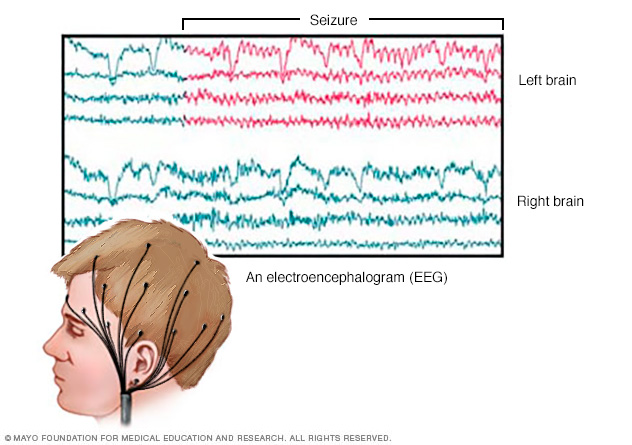
An EEG records the electrical activity of the brain via electrodes affixed to the scalp. EEG results show changes in brain activity that may be useful in diagnosing brain conditions, especially epilepsy and other seizure disorders.
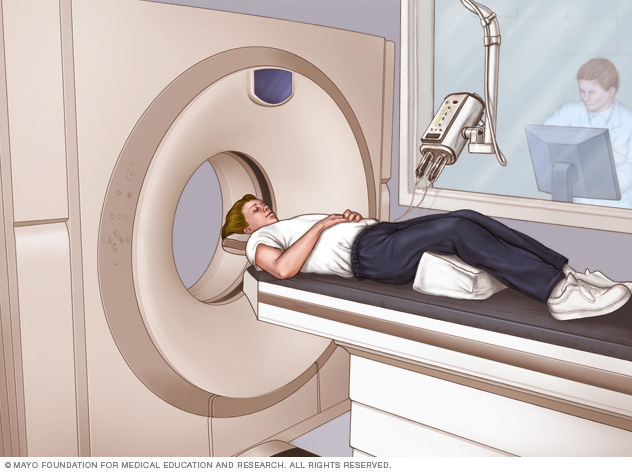
A CT scan can be used to visualize nearly all parts of the body and is used to diagnose disease or injury as well as to plan medical, surgical or radiation treatment.
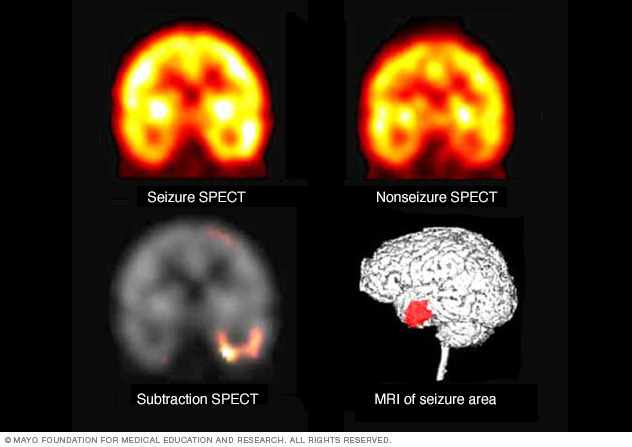
This example shows SPECT scans taken during and between seizures. The differences represent areas where blood flow increased during the seizure. Once identified, that location is fitted onto an MRI image of the brain.
Treatment
Doctors generally begin by treating epilepsy with medication. If medications don't treat the condition, doctors may propose surgery or another type of treatment.
Medication
Most people with epilepsy can become seizure-free by taking one anti-seizure medication, which is also called anti-epileptic medication. Others may be able to decrease the frequency and intensity of their seizures by taking a combination of medications.
Many children with epilepsy who aren't experiencing epilepsy symptoms can eventually discontinue medications and live a seizure-free life. Many adults can discontinue medications after two or more years without seizures. Your doctor will advise you about the appropriate time to stop taking medications.
Finding the right medication and dosage can be complex. Your doctor will consider your condition, frequency of seizures, your age and other factors when choosing which medication to prescribe. Your doctor will also review any other medications you may be taking, to ensure the anti-epileptic medications won't interact with them.
Your doctor likely will first prescribe a single medication at a relatively low dosage and may increase the dosage gradually until your seizures are well controlled.
There are more than 20 different types of anti-seizure medications available. The medication that your doctor chooses to treat your epilepsy depends on the type of seizures you have, as well as other factors such as your age and other health conditions.
These medications may have some side effects. Mild side effects include:
- Fatigue
- Dizziness
- Weight gain
- Loss of bone density
- Skin rashes
- Loss of coordination
- Speech problems
- Memory and thinking problems
More-severe but rare side effects include:
- Depression
- Suicidal thoughts and behaviors
- Severe rash
- Inflammation of certain organs, such as your liver
To achieve the best seizure control possible with medication, follow these steps:
- Take medications exactly as prescribed.
- Always call your doctor before switching to a generic version of your medication or taking other prescription medications, over-the-counter drugs or herbal remedies.
- Never stop taking your medication without talking to your doctor.
- Notify your doctor immediately if you notice new or increased feelings of depression, suicidal thoughts, or unusual changes in your mood or behaviors.
- Tell your doctor if you have migraines. Doctors may prescribe one of the anti-epileptic medications that can prevent your migraines and treat epilepsy.
At least half the people newly diagnosed with epilepsy will become seizure-free with their first medication. If anti-epileptic medications don't provide satisfactory results, your doctor may suggest surgery or other therapies. You'll have regular follow-up appointments with your doctor to evaluate your condition and medications.
Surgery
When medications fail to provide adequate control over seizures, surgery may be an option. With epilepsy surgery, a surgeon removes the area of your brain that's causing seizures.
Doctors usually perform surgery when tests show that:
- Your seizures originate in a small, well-defined area of your brain
- The area in your brain to be operated on doesn't interfere with vital functions such as speech, language, motor function, vision or hearing
For some types of epilepsy, minimally invasive approaches such as MRI-guided stereotactic laser ablation may provide effective treatment when an open procedure may be too risky. In these procedures, doctors direct a thermal laser probe at the specific area in the brain causing seizures to destroy that tissue in an effort to better control the seizures.
Although many people continue to need some medication to help prevent seizures after successful surgery, you may be able to take fewer drugs and reduce your dosages.
In a small number of cases, surgery for epilepsy can cause complications such as permanently altering your thinking (cognitive) abilities. Talk to your surgeon about his or her experience, success rates, and complication rates with the procedure you're considering.
Therapies
Apart from medications and surgery, these potential therapies offer an alternative for treating epilepsy:
-
Vagus nerve stimulation. In vagus nerve stimulation, doctors implant a device called a vagus nerve stimulator underneath the skin of your chest, similar to a heart pacemaker. Wires from the stimulator are connected to the vagus nerve in your neck.
The battery-powered device sends bursts of electrical energy through the vagus nerve and to your brain. It's not clear how this inhibits seizures, but the device can usually reduce seizures by 20-40%.
Most people still need to take anti-epileptic medication, although some people may be able to lower their medication dose. You may experience side effects from vagus nerve stimulation, such as throat pain, hoarse voice, shortness of breath or coughing.
-
Ketogenic diet. Some children with epilepsy have been able to reduce their seizures by following a strict diet that's high in fats and low in carbohydrates.
In this diet, called a ketogenic diet, the body breaks down fats instead of carbohydrates for energy. After a few years, some children may be able to stop the ketogenic diet — under close supervision of their doctors — and remain seizure-free.
Consult a doctor if you or your child is considering a ketogenic diet. It's important to make sure that your child doesn't become malnourished when following the diet.
Side effects of a ketogenic diet may include dehydration, constipation, slowed growth because of nutritional deficiencies and a buildup of uric acid in the blood, which can cause kidney stones. These side effects are uncommon if the diet is properly and medically supervised.
Following a ketogenic diet can be a challenge. Low-glycemic index and modified Atkins diets offer less restrictive alternatives that may still provide some benefit for seizure control.
- Deep brain stimulation. In deep brain stimulation, surgeons implant electrodes into a specific part of your brain, typically your thalamus. The electrodes are connected to a generator implanted in your chest. The generator regularly sends electrical pulses to your brain at timed intervals, and may reduce your seizures. Deep brain stimulation is often used for people whose seizures don't get better with medication.
- Responsive neurostimulation. These implantable, pacemaker-like devices can help significantly reduce how often seizures occur. These responsive stimulation devices analyze brain activity patterns to detect seizures as they start and deliver an electrical charge or drug to stop the seizure before it causes impairment. Research shows that this therapy has few side effects and can provide long-term seizure relief.
Potential future treatments
Researchers are studying many potential new treatments for epilepsy, including:
- Continuous stimulation of the seizure onset zone (subthreshold stimulation). Subthreshold stimulation — continuous stimulation to an area of your brain below a level that's physically noticeable — appears to improve seizure outcomes and quality of life for some people with seizures. Subthreshold stimulation helps stop a seizure before it happens. This treatment approach may work in people who have seizures that start in an area of the brain that can't be removed because it would affect speech and motor functions (eloquent area). Or it might benefit people whose seizure characteristics mean their chances of successful treatment with responsive neurostimulation are low.
- Minimally invasive surgery. New minimally invasive surgical techniques, such as MRI-guided focused ultrasound, show promise at treating seizures with fewer risks than traditional open-brain surgery for epilepsy.
- Transcranial magnetic stimulation (TMS). TMS applies focused magnetic fields on areas of the brain where seizures occur to treat seizures without the need for surgery. It may be used for patients whose seizures occur close to the surface of the brain and are not candidates for surgery.
- External trigeminal nerve stimulation. Similar to vagus nerve stimulation, this device would stimulate specific nerves to reduce frequency of seizures. But unlike vagus nerve stimulation, this device would be worn externally so that no surgery to implant the device is needed. In studies, external trigeminal nerve stimulation provided improvements in both seizure control and mood.
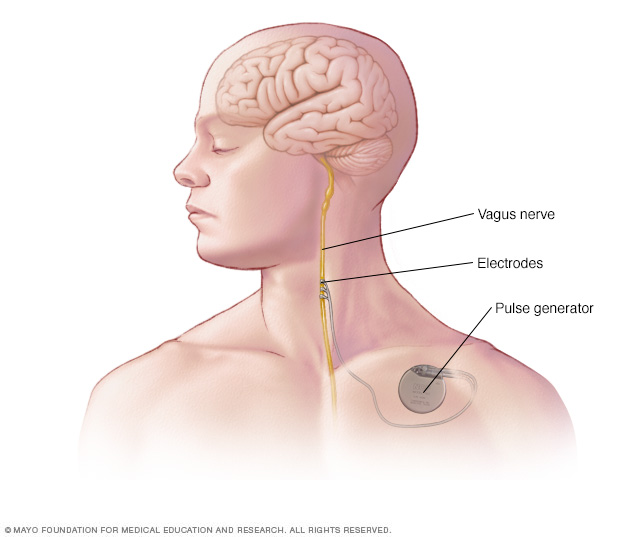
In vagus nerve stimulation, an implanted pulse generator and lead wire stimulate the vagus nerve, which leads to stabilization of abnormal electrical activity in the brain.
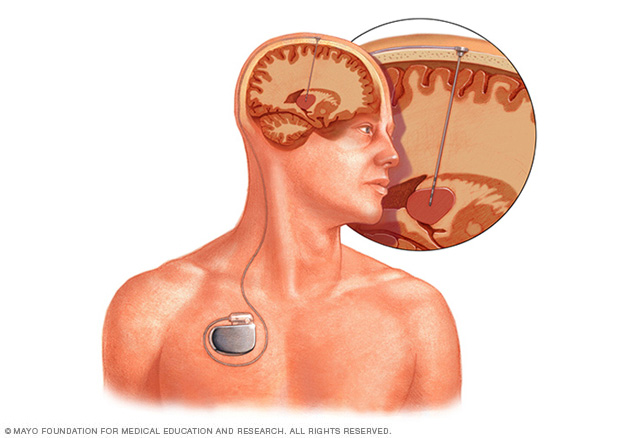
Deep brain stimulation involves implanting an electrode deep within the brain. The amount of stimulation delivered by the electrode is controlled by a pacemaker-like device placed under the skin in your chest. A wire that travels under your skin connects the device to the electrode.
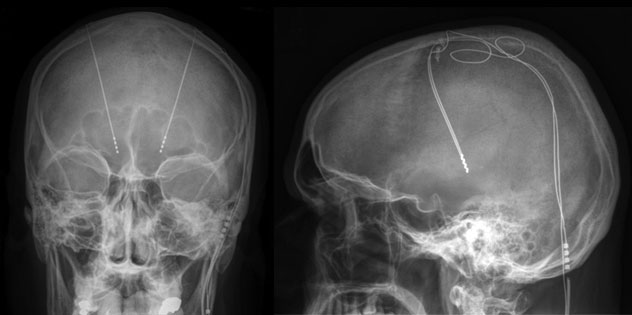
A magnetic resonance imaging (MRI) scan of deep brain stimulation shows the location of electrodes placed in the brain.
Lifestyle and home remedies
Understanding your condition can help you take better control of it:
- Take your medication correctly. Don't adjust your dosage before talking to your doctor. If you feel your medication should be changed, discuss it with your doctor.
- Get enough sleep. Lack of sleep can trigger seizures. Be sure to get adequate rest every night.
- Wear a medical alert bracelet. This will help emergency personnel know how to treat you correctly.
- Exercise. Exercising may help keep you physically healthy and reduce depression. Make sure to drink enough water, and rest if you get tired during exercise.
In addition, make healthy life choices, such as managing stress, limiting alcoholic beverages and avoiding cigarettes.
Coping and support
Uncontrolled seizures and their effects on your life may at times feel overwhelming or lead to depression. It's important not to let epilepsy hold you back. You can still live an active, full life. To help cope:
- Educate yourself and your friends and family about epilepsy so that they understand the condition.
- Try to ignore negative reactions from people. It helps to learn about epilepsy so that you know the facts as opposed to misconceptions about the disease. And try to keep your sense of humor.
- Live as independently as possible. Continue to work, if possible. If you can't drive because of your seizures, investigate public transportation options near you. If you aren't allowed to drive, you might consider moving to a city with good public transportation options.
- Find a doctor you like and with whom you feel comfortable.
- Try not to constantly worry about having a seizure.
- Find an epilepsy support group to meet people who understand what you're going through.
If your seizures are so severe that you can't work outside your home, there are still ways to feel productive and connected to people. You may consider working from home.
Let people you work and live with know the correct way to handle a seizure in case they are with you when you have one. You may offer them suggestions, such as:
- Carefully roll the person onto one side to prevent choking.
- Place something soft under his or her head.
- Loosen tight neckwear.
- Don't try to put your fingers or anything else in the person's mouth. No one has ever "swallowed" his or her tongue during a seizure — it's physically impossible.
- Don't try to restrain someone having a seizure.
- If the person is moving, clear away dangerous objects.
- Stay with the person until medical personnel arrive.
- Observe the person closely so that you can provide details on what happened.
- Time the seizures.
- Be calm during the seizures.
Preparing for an appointment
You're likely to start by seeing your family doctor or a general practitioner. However, in some cases when you call to set up an appointment, you may be referred immediately to a specialist, such as a doctor trained in brain and nervous system conditions (neurologist) or a neurologist trained in epilepsy (epileptologist).
Because appointments can be brief, and because there's often a lot to talk about, it's a good idea to be well prepared for your appointment. Here's some information to help you get ready for your appointment, and what to expect from your doctor.
What you can do
-
Keep a detailed seizure calendar. Each time a seizure occurs, write down the time, the type of seizure you experienced and how long it lasted. Also make note of any circumstances, such as missed medications, sleep deprivation, increased stress, menstruation or other events that might trigger seizure activity.
Seek input from people who may observe your seizures, including family, friends and co-workers, so that you can record information you may not know.
- Be aware of any pre-appointment restrictions. At the time you make the appointment, ask if there's anything you need to do in advance, such as restrict your diet.
- Write down key personal information, including any major stresses or recent life changes.
- Make a list of all medications, vitamins or supplements that you're taking.
-
Take a family member or friend along. Sometimes it can be difficult to remember all the information provided to you during an appointment. Someone who accompanies you may remember something that you missed or forgot.
Also, because you may not be aware of everything that happens when you're having a seizure, your doctor may want to ask questions of someone who has witnessed them.
- Write down questions to ask your doctor. Preparing a list of questions will help you make the most of your time with your doctor.
For epilepsy, some basic questions to ask your doctor include:
- What is likely causing my seizures?
- What kinds of tests do I need?
- Is my epilepsy likely temporary or chronic?
- What treatment approach do you recommend?
- What are the alternatives to the primary approach that you're suggesting?
- How can I make sure that I don't hurt myself if I have another seizure?
- I have these other health conditions. How can I best manage them together?
- Are there any restrictions that I need to follow?
- Should I see a specialist? What will that cost, and will my insurance cover it?
- Is there a generic alternative to the medicine you're prescribing?
- Are there any brochures or other printed material that I can take home with me? What websites do you recommend?
In addition to the questions that you've prepared to ask your doctor, don't hesitate to ask questions during your appointment at any time that you don't understand something.
What to expect from your doctor
Your doctor is likely to ask you a number of questions, such as:
- When did you first begin experiencing seizures?
- Do your seizures seem to be triggered by certain events or conditions?
- Do you have similar sensations just before the onset of a seizure?
- Have your seizures been frequent or occasional?
- What symptoms do you have when you experience a seizure?
- What, if anything, seems to improve your seizures?
- What, if anything, appears to worsen your seizures?
What you can do in the meantime
Certain conditions and activities can trigger seizures, so it may be helpful to:
- Avoid drinking excessive amounts of alcohol
- Avoid using nicotine
- Get enough sleep
- Reduce stress
Also, it's important to start keeping a log of your seizures before you visit your doctor.
Copyright © 1998-2026 Mayo Foundation for Medical Education and Research (MFMER). All rights reserved.